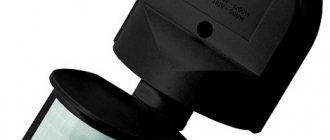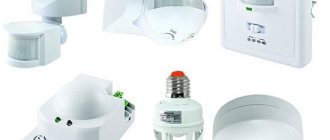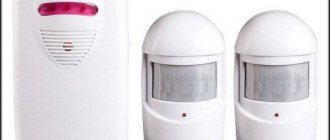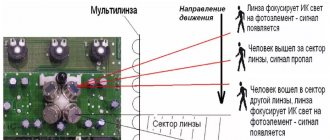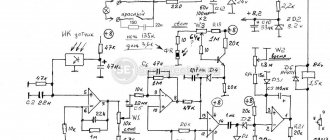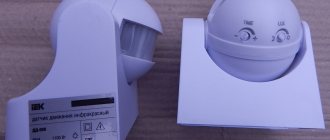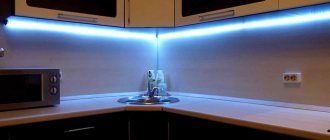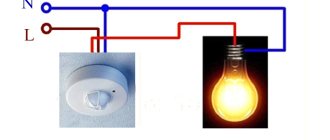It is unwise to turn on lighting in some rooms or outdoors for the entire dark period. To ensure that the light turns on only when needed, a motion sensor is installed in the lamp’s power circuit. In the “normal” state, it breaks the power circuit. When a moving object appears in its coverage area, the contacts close and the lighting turns on. After the object disappears from the coverage area, the light turns off. This operating algorithm has proven itself excellent in street lighting, in lighting utility rooms, corridors, basements, entrances and stairs. In general, in those places where people appear only periodically. So, for savings and convenience, it is better to install a motion sensor to turn on the light.
Types and varieties
Motion sensors for turning on lights can be of different types, designed for different operating conditions. First of all, you need to look at where the device can be installed.
A motion sensor to turn on the lights is needed not only on the street
Outdoor motion sensors have a high degree of housing protection. For normal use outdoors, take sensors with an IP of at least 55, but better - higher. For installation in a home, you can take IP 22 and higher.
Power type
Next, you need to consider what source the light sensor is powered from. There are the following options:
- Wired sensors powered by 220 V.
- Wireless, powered by batteries or rechargeable batteries.
Motion sensors are wired and wireless
The largest group is wired for connecting to 220 V. There are fewer wireless ones, but there are also enough of them. They are good if you need to turn on lighting powered by low-voltage power sources - rechargeable batteries or solar panels, for example.
Method for determining the presence of motion
The motion sensor for turning on the light can detect moving objects using various detection principles:
- Infrared motion sensors. They react to the heat generated by the body of warm-blooded creatures. They are classified as passive devices, since they themselves do not produce anything, they only register radiation. These sensors also react to the movement of animals, so there may be false alarms.
- Acoustic motion (noise) sensors. Also belongs to the passive group of equipment. They react to noise and can be turned on by a clap or the sound of a door opening. They can be used in the basements of private houses, where noise occurs as soon as someone enters there. Use elsewhere is limited.
The operation of infrared motion sensors is based on tracking the heat generated by a person - Microwave motion sensors. Belong to the group of active devices. They themselves produce waves in the microwave range and monitor their return. In the presence of a moving object, contacts are closed/opened (there are different types). There are sensitive models that “see” even through partitions or walls. Typically used in security systems.
- Ultrasonic. The principle of operation is the same as that of microwaves, but the range of emitted waves is different. This type of device is rarely used, since animals can react to ultrasound, and long-term exposure to humans (the devices constantly generate radiation) will not bring any benefit.
Various designs, but the color is mainly white and black - Combined (dual). Combines several motion detection methods. They are more reliable, have fewer false positives, but are also more expensive.
Most often, infrared motion sensors are used to turn on lights on the street or at home. They have a low price, a large range of action, and a large number of adjustments that will help you customize it. On stairs and in long corridors it is better to install a sensor with ultrasound or microwave. They are able to turn on the lighting even if you are still far from the light source. Microwaves are recommended for installation in security systems - they detect movement even behind partitions.
Basic parameters that require analysis when choosing a device
Placement . If you purchase a model for a dry room, then the degree of protection according to the IP20–22 standard is sufficient. For rooms with high humidity and open outdoor spaces, devices with protection from IP44 and higher are suitable.
Power . The higher the sensor power value, the more lighting fixtures can be linked to it.
Signal passability . For normal operation of infrared recorders, it is necessary to eliminate obstacles. But microwave and combined models, as we have already noticed, are not afraid of obstacles.
Operating range and viewing angle . Here you should take a guideline on the shape and width of the premises, as well as the distance at which the sensor should operate.
Sensitivity . It is desirable that it be customizable, otherwise the sensor will trigger falsely not only on pets, but even on frogs and small rodents.
Adjusting the light level . If there is no such regulator, then the sensor can only be mounted in conditions of equal illumination. However, most models can be adjusted - for example, to operate only in complete darkness.
Specifications
Once you have decided which motion sensor you will install to turn on the lights, you need to select its technical characteristics.
The technical characteristics of wireless models also include the frequency at which they operate and the type of batteries
Viewing angle
The motion sensor for turning on the light can have a different viewing angle in the horizontal plane - from 90° to 360°. If an object can be approached from any direction, sensors with a radius of 180-360° are installed, depending on its location. If the device is mounted on a wall, 180° is enough, if on a pole, 360° is already needed. Indoors, you can use those that track movement in a narrow sector.
Depending on the installation location and the required detection zone, select the viewing radius
If there is only one door (a utility room, for example), a narrowband sensor may be sufficient. If the room can be entered from two or three sides, the model should be able to see at least 180°, and better yet, in all directions. The wider the coverage, the better, but the cost of wide-angle models is much higher, so you should proceed from the principle of reasonable sufficiency.
There is also a vertical viewing angle. In ordinary inexpensive models it is 15-20°, but there are models that can cover up to 180°. Wide-angle motion detectors are usually installed in security systems, and not in lighting systems, since their cost is considerable. In this regard, it is worth choosing the correct height for installing the device: so that the “dead zone”, in which the detector simply does not see anything, is not in the place where the movement is most intense.
Range
Here again, you should choose taking into account whether a motion sensor will be installed indoors to turn on the lights or outdoors. For indoor environments, a range of 5-7 meters is sufficient.
Choose range with reserve
For the street, it is desirable to install more “long-range” ones. But look here too: with a large coverage radius, false positives can be very frequent. So having too much coverage can even be a disadvantage.
Power of connected luminaires
Each motion sensor for turning on the light is designed to connect a certain load - it can pass a current of a certain rating through itself. Therefore, when choosing, you need to know the total power of the lamps that the device will connect.
The power of the connected lamps is critical if a group of lamps or one powerful one is turned on
In order not to overpay for the increased capacity of the motion sensor, and even save on electricity bills, use not incandescent lamps, but more economical ones - gas discharge, fluorescent or LED.
Installation method and location
In addition to the obvious division into street and “home”, there is another type of division according to the location of installation of motion sensors:
- Case models. A small box that can be mounted on a bracket. The bracket can be fixed: on the ceiling;
- on the wall.
The type of motion sensor cannot be determined by its appearance, you can only understand whether it is installed on the ceiling or on the wall
If the lighting is turned on only to increase comfort, cabinet models are chosen, since they are cheaper with equal characteristics. Built-in ones are installed in security systems. They are miniature, but more expensive.
Additional functions
Some motion detectors have additional features. Some of them are obvious overkill, others, in certain situations, can be useful.
- Built-in light sensor. If a motion sensor to turn on the light is installed on the street or in a room with a window, there is no need to turn on the light during daylight hours - the illumination is sufficient. In this case, either a photo relay is built into the circuit, or a motion detector with a built-in photo relay is used (in one housing).
- Protection from animals. A useful feature if you have cats or dogs. With this function there are much fewer false positives. If the dog is large, even this option will not save you. But it works well with cats and small dogs.
For many, a useful feature would be protection against triggering when animals appear. - Light off delay. There are devices that turn off the light immediately after the object leaves the coverage area. In most cases this is inconvenient: light is still needed. That’s why models with a delay are convenient, and even more convenient are those that allow you to adjust this delay.
These are all features that may be useful. Pay special attention to animal protection and shutdown delay. These are really useful options.
Comparison of models
For clarity, let’s create a table of the sensors we reviewed with their characteristics.
| Model | Viewing angle, degrees | Range, m | Maximum load power, W | Installation height, m | Dimensions, mm | Weight, g |
| Orbis 360 degrees CIRCUMAT PRO CR white DU OB134912 | 360 | 30 | 2200 | 7 | 140x80x175 | 340 |
| IP44 Brennenstuhl 1170900(180 degrees) | 180 | 12 | 1000 | 7 | 100x150x75 | 220 |
| Feron Sen 30 230V 500W 5-8 cm 30 with white cable 1.5 m 22068 | 30 | 0,08 | 500 | – | 79x35x19 | 61 |
| TDM DDM-02 SQ0324-0021 | 180 | 8 | 1200 | 3,5 | 86.4x60.4x98 | 180 |
| Camelion LX-28A 6438 | 360 | 6 | 1200 | 2,5 | 120x65x120 | 149 |
| Rev Ritter "Action" 110 | 110 | 12 | 1000 | 2,5 | 120x65x120 | 185 |
| EKF PROxima dd-ms-22B | 360 | 6 | 2000 | 4 | 115x25x115 | 110 |
This is interesting: How to make a floor lamp with your own hands - photos, videos, master classes
Where to place
You need to install the motion sensor correctly to turn on the lighting - for it to work correctly, follow certain rules:
- There should be no lighting devices nearby. Light interferes with correct operation.
- There should be no heating or air conditioning units nearby. Motion detectors of any type react to air currents.
As the installation height increases, the detection zone increases, but the sensitivity decreases - There should be no large objects. They obscure large areas.
In large rooms it is better to install the device on the ceiling. Its viewing radius should be 360°. If the sensor must turn on the lighting from any movement in the room, it is installed in the center; if only some part is monitored, the distance is selected so that the “dead zone” of the ball is minimal.
Application
Motion sensors are most often used to control lighting fixtures. And the point here is not only about comfort, but also about savings: their use can significantly reduce energy consumption for lighting.
In addition, motion sensors are used as part of security systems, to control automatic doors, garage or warehouse doors, as well as in smart home systems, for example, to automate the operation of climate control equipment. Thus, using motion sensors, you can turn air conditioners on and off, regulate heating power, start boilers, etc.
Motion sensor to turn on the light: installation diagrams
In the simplest case, the motion sensor is connected to the break in the phase wire that goes to the lamp. If we are talking about a dark room without windows, this scheme is workable and optimal.
Scheme for connecting a motion sensor to turn on the light in a dark room
If we talk specifically about connecting the wires, then phase and zero are connected to the input of the motion sensor (usually labeled L for phase and N for neutral). From the output of the sensor, the phase is supplied to the lamp, and we take the zero and ground to it from the panel or from the nearest junction box.
If we are talking about street lighting or turning on the light in a room with windows, you will need to either install a light sensor (photo relay) or install a switch on the line. Both devices prevent the lights from turning on during daylight hours. It’s just that one (photo relay) operates in automatic mode, and the second is turned on forcibly by a person.
Wiring diagram for a motion sensor on the street or in a room with windows. There may be a photo relay in place of the switch
They are also placed in the break of the phase wire. Only when using a light sensor, it must be placed in front of the motion relay. In this case, it will receive power only after it gets dark and will not work “idle” during the day. Since any electrical appliance is designed for a certain number of operations, this will extend the life of the motion sensor.
All the schemes described above have one drawback: the lighting cannot be turned on for a long time. If you need to do some work on the stairs in the evening, you will have to move all the time, otherwise the light will periodically turn off.
Connection diagram for a motion sensor with the ability to turn on the lighting for a long time (bypassing the sensor)
To make it possible to turn on the lighting for a long time, a switch is installed in parallel with the detector. While it is turned off, the sensor is in operation, the light turns on when it is triggered. If you need to turn on the lamp for a long period, flip the switch. The lamp stays on until the switch is turned to the off position again.
Lamp design features
The difference between a light bulb with a motion sensor and the most ordinary one is the presence of a responsive element. The shell is made in the form of a lantern, floor lamp, chandelier or shade. Paired with a motion detector, different types of lamps are used: LED, fluorescent, halogen.
The most successful is a tandem with an LED lamp. These functional devices are compact and easy to install. LED models are sometimes additionally equipped with an independent control relay or controller. Thanks to the presence of these options, you can control both the brightness and glow parameters.
The photo shows a lamp with a Lemanso lm650 motion sensor. The device is used to illuminate any room. Installation is extremely simple—similar to screwing in a regular light bulb
In some cases, protective systems are included in the circuit to protect against short circuits, temperature overloads, and high voltages. Regardless of the internal configuration, the operating principle of such lamps is unchanged: the lighting device must have a reading element - a sensor.
Advantages and disadvantages of lamps with motion detectors
A lamp with an electronic eye has many advantages. These devices are very convenient - when the system switches to automatic mode, there is no need for manual control.
Another advantage is the versatility of the lamps. They can be equipped with any type of light element, from a simple incandescent lamp to the most modern and economical light bulb.
Manufacturers produce these devices in a wide range of sizes. Since they only work periodically, they have a long service life. Lamps can be very decorative, so they are often used in landscaping.
High-quality luminaires with motion detection have mechanical and electronic adjustment levels. In the first case, we mean the angle of inclination, and in the second - the glow time, the sensitivity of the sensor
An alarm system can be connected to a lamp with a motion sensor. Such an alliance will help protect the yard from robbers. A good solution is a lamp with a beam configured according to all the rules and placed above the front door or in a dark garage. But the main advantage is considered to be the efficiency of these lighting devices. They save from 50 to 70% of electricity.
The disadvantages include two features of such lamps. The first is that the sensor is not able to detect movement that is perpendicular to it. Secondly, such a device is of little use for a room where people stay for a long time.
Adjustment (setting)
After installation, the motion sensor must be configured to turn on the light. There are small rotary controls on the body to adjust almost all parameters. They can be turned by inserting your fingernail into the slot, but it is better to use a small screwdriver. Let us describe the adjustment of a DD-type motion sensor with a built-in light sensor, since they are most often installed in private homes to automate street lighting.
Tilt angle
For those sensors that are mounted on walls, you first need to set the angle of inclination. They are mounted on rotating brackets, with the help of which their position changes. It must be selected so that the controlled area is the largest. It is impossible to give exact recommendations, since it depends on the vertical viewing angle of the model and on the height at which you hung it.
Adjusting the motion sensor begins with selecting the angle of inclination
The optimal installation height for the motion sensor is about 2.4 meters. In this case, even those models that can cover only 15-20° vertically control sufficient space. Adjusting the incline is a very rough name for what you'll be doing. You will gradually change the angle of inclination, check how the sensor works in this position from different possible entry points. It's not difficult, but it's tedious.
Sensitivity
On the body this adjustment is labeled SEN (from English sensitive - sensitivity). The position can be changed from minimum (min/low) to maximum (max/hight).
Basically, the settings look like this
This is one of the most difficult settings, since it determines whether the sensor will work on small animals (cats and dogs). If the dog is large, it will not be possible to avoid false alarms. With medium and small animals this is quite possible. The setup procedure is as follows: set it to minimum, check how it works for you and for inhabitants of smaller stature. If necessary, increase the sensitivity little by little.
Delay time
Different models have different shutdown delay ranges - from 3 seconds to 15 minutes. You need to insert it the same way - by turning the adjusting wheel. It is usually signed Time (translated from English as “time”).
Glow time or delay time - choose what you like best
Everything is relatively easy here - knowing the minimum and maximum of your model, you can approximately choose a position. After turning on the flashlight, freeze and note the time after which it will turn off. Next, change the position of the regulator in the desired direction.
Light level
This adjustment relates to the photo relay, which, as we agreed, is built into our motion sensor to turn on the light. If there is no built-in photo relay, it simply will not exist. This adjustment is labeled LUX, the extreme positions are labeled min and max.
They can be located on the front or back side of the case
When connecting, set the regulator to the maximum position. And in the evening, at the level of illumination when you think the light should already turn on, turn the regulator slowly to the min position until the lamp/lantern turns on.
Now we can assume that the motion relay is configured.
Common problems
Sometimes, after installation, the motion sensor does not work as expected. Common problems include:
- After activation, the lighting device does not turn off. To fix the problem, you need to check the delay settings.
- Lack of response to movement. You need to set the maximum value of the LUX regulator. If the sensor starts working, then you need to make adjustments. If not, the device is most likely faulty.
- Incorrect installation. There may be objects between the sensor and the control area that obstruct the signal, which means the sensor will not work as it should. If it is located next to a lighting fixture, false alarms may occur (as well as near heating pipes).
- Lamp burnout. Sometimes the problem of a non-working device is very simple - you just need to replace the lamp.
- Wiring fault. To identify it, you need to carry out diagnostics on all sections of the chain. If a problem is detected, you need to de-energize the system and replace the cable at the fault location.
Sometimes the problem lies in improper use. Most often, high humidity is not taken into account, and water can damage the device.
This device can be a great helper on the street. It will add comfort and ensure safety. The main thing is to take into account all the needs when choosing the device itself and install it correctly.


